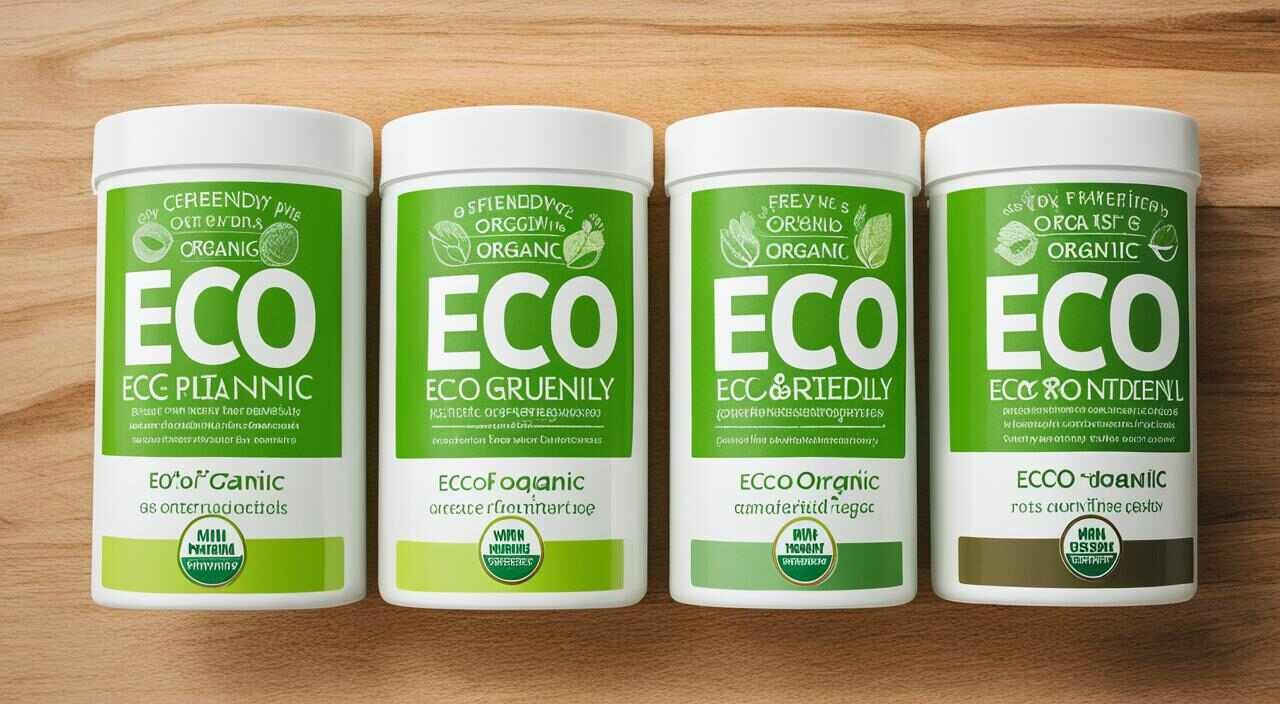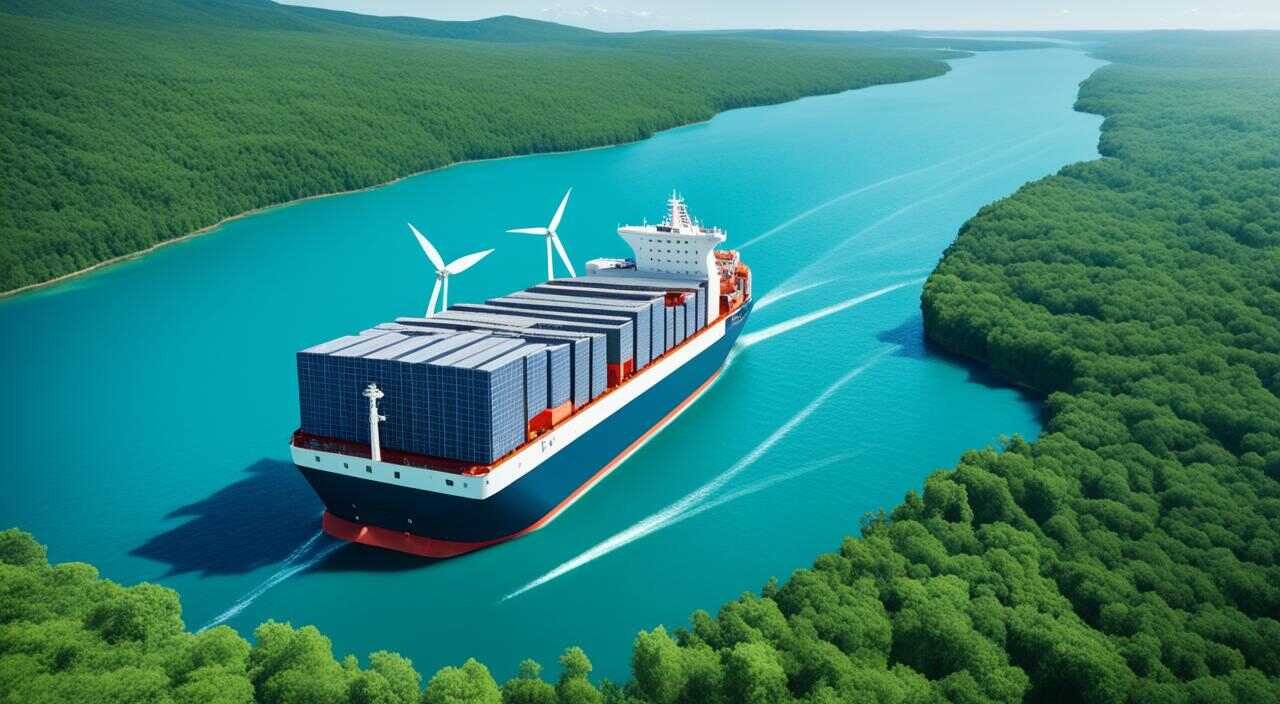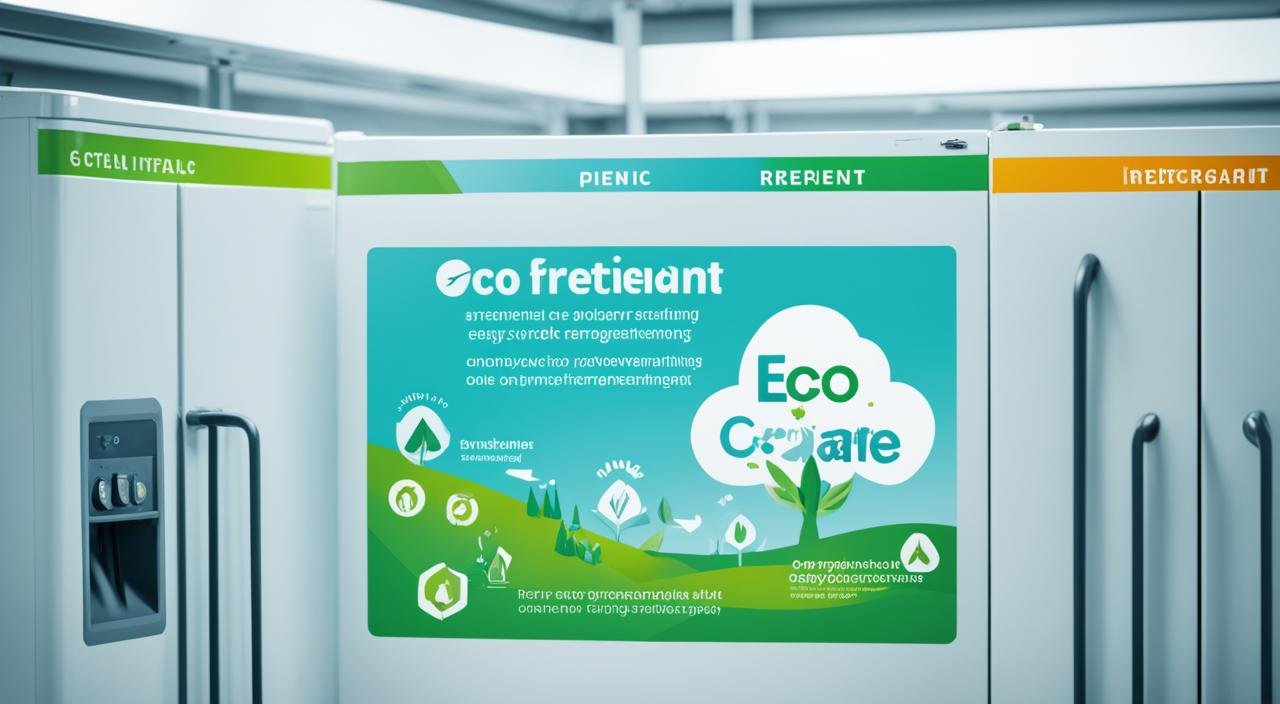There’s often confusion around what “eco-friendly” and “organic” mean. It’s key to know the difference. Being eco-friendly means we try to lessen our effect on the planet. On the other hand, being organic is about avoiding synthetic chemicals. Let’s look closer to understand these terms better.
Key Takeaways:
- Eco-friendly products aim to minimize the impact of human activity on the environment.
- Organic products are grown or produced without the use of synthetic chemicals.
- Understanding the difference between eco-friendly and organic can help consumers make informed choices.
- Eco-friendly and organic practices are not synonymous, although there may be some overlap.
- Both eco-friendly and organic products play a crucial role in promoting sustainability and reducing environmental impact.
What Does Eco-Friendly Mean?
Eco-friendly products are made to harm the Earth less. They work towards a goal of keeping nature safe and pure. These items cut down on trash, save resources, and lessen harmful waste.
Eco-friendly practices range widely, all with nature’s benefit at heart. They depend on things like the sun or wind to limit fossil fuel use. Many of these goods come from reused or natural materials. This cuts down the damage they cause.
Labelling is vital for eco-friendly items. It helps shoppers pick those that are kinder to the planet. These tags tell us about a product’s green qualities.
Common eco-friendly endorsements are keys to launch, including:
- Energy Star: This tag means a product is top-notch for saving energy, as okayed by the EPA. Buying Energy Star items helps cut your energy use. This means less harm to the planet and a healthier world for us.
- USDA Organic: This isn’t just for food. It shows a product was made without man-made chemicals. This can also point to other Earth-friendly steps taken in its making.
- Fair Trade: This certification stands for ethical and eco-safe sourcing. It ensures fair dealing for people making the product and helps care for their local area.
Seeing these labels on items gives us assurance. It means these products have met hard environmental tests. By choosing them, we are helping the Earth in our way, aiming for a planet that thrives together with us.
Eco-Friendly Products: A Visual Breakdown
| Label | Description | Criteria |
|---|---|---|
| Energy Star | Highlights energy-saving products | Makes sure products are very efficient, meeting EPA standards |
| USDA Organic | Tells of organic and green goods | Produces free from artificial chemicals, follows careful sustainable steps |
| Fair Trade | Stresses ethical and green sourcing | Promotes even prices, helps local areas, and saves the planet |
What Does Organic Mean?
Organic products are grown, produced, or made without synthetic chemicals. This includes pesticides, fertilizers, or growth hormones. The term “organic” isn’t just for food. It also means eco-friendly clothing, cosmetics, and household items. Organic farming helps the earth by focusing on soil health, biodiversity, and ecological balance. This way, it supports sustainable farming and protects the environment.
To be labeled organic, products must meet set standards. Important organizations like the USDA or the Soil Association check that products are truly organic. They make sure organic products are made the right way. This includes using safe farming methods and follows clear rules for labels and marketing.
Organic Certification Criteria
The criteria for organic certification is really important. Here are the main factors:
- Absence of Synthetic Chemicals: Organic products can’t use synthetic chemicals. This rule is strict to keep products safe and not harmful to health. It also protects the environment from bad effects.
- Soil Health: Organic farming cares a lot about soil. Farmers use natural ways to keep the soil healthy. They don’t use harmful chemicals. Instead, they use methods like composting and rotate crops. This helps keep the soil nutrient-rich and in good shape for growing.
- Biodiversity Conservation: Organic farming helps keep nature in balance by using many plant types. Farmers use natural ways to control pests and diseases. They also protect areas for helpful animals. All this helps to keep the environment strong and diverse.
- Animal Welfare: With organic animal products, the way animals are treated is critical. Livestock must be able to go outside and eat organic food. Farming practices keep stress low and let animals act naturally.
Getting organic certification shows that a product is truly organic. It lets consumers know they are choosing something healthy and good for the planet. It gives people a way to support farming that matches their beliefs and values.
| Organic Certification Standards | Organization |
|---|---|
| United States Department of Agriculture (USDA Organic) | USDA |
| Soil Association Organic Certification | Soil Association |
| European Union Organic Certification | European Commission |
| Japan Organic Certification | Ministry of Agriculture, Forestry, and Fisheries (MAFF) |
Choosing organic products is a way to support the earth and its creatures. It helps use natural resources wisely and keeps biodiversity strong. Going for organic means less synthetic chemicals hurting the environment.
Is There Overlap Between Eco-Friendly and Organic?
It’s key to know that eco-friendly and organic aren’t the same but share some connections. Many eco-friendly methods are used in organic farming, making them overlap. Yet, not all eco-friendly items are organic, and vice versa.
Organic farming often involves eco-friendly practices. Farmers focus on being kind to the planet and use methods that help the environment. They might:
- Utilize solar power and other renewable energy sources
- Care for the soil through organic fertilizers and methods that help biodiversity
- Use water efficiently with smart irrigation systems
- Lessen waste and find ways to recycle
These efforts in organic farming make sure its products are made in ways that protect our planet. Yet, not everything that’s eco-friendly is also organic. This means eco-friendly actions boost how sustainable organic farming is.
“Eco-friendly practices can be adopted in organic farming, such as using renewable energy sources or reducing waste.” – Organic Farmer
For instance, a product might use green packaging, which is good for the earth. However, what’s inside might not be organic. Or, a product could be organic but not rely solely on eco-friendliness.
The Importance of Packaging in Eco-Friendly and Organic Products
When it comes to being eco-friendly and organic, packaging matters a lot. It’s about using materials that cause less waste. These materials can be recycled or break down naturally, with a focus on cutting back on plastic use. This way, the packaging doesn’t harm the planet and keeps the products safe.
Organic packaging takes it a step further. It stops organic items from getting mixed up with non-organic ones. This is key for consumers looking for truly organic choices. They want to be sure their products are pure.
Finding packaging that’s both eco and organic isn’t easy for companies. They have to use materials that are good for the earth but also keep up with organic standards. This takes new ideas, working together, and knowing a lot about environmental and organic ways.
| Eco-Friendly Packaging | Sustainable Packaging | Organic Packaging |
|---|---|---|
| Reduces waste | Uses recyclable or biodegradable materials | Prevents contamination |
| Minimizes the use of plastic | Promotes product integrity | Upholds the organic claim |
| Focuses on environmental impact | Minimizes environmental footprint | Ensures organic products remain organic |
Effective packaging design prioritizes sustainability without compromising product quality and consumer experience.
The more we learn about packaging’s impact, the more we want eco-friendly and organic choices. Companies should choose packaging that reflects their care for the environment and meets what customers expect. This helps our planet and people too.
Using green and organic packaging sets businesses apart as leaders in caring for Earth. It attracts buyers who value the environment. Plus, it shows the company is ethical and worth supporting.
Consumer Preferences and Eco-Friendly vs. Organic Products
Consumers today care a lot about how their purchases affect the environment. They look for sustainable choices in everything, from household goods to food. This has led to a big demand for eco-friendly and organic products.
Studies show that people like packaging that’s easy on the planet. They prefer things they can recycle or that break down naturally. Choosing these options means less trash and a smaller carbon footprint, which many care about.
“I always look for products with eco-friendly packaging. It gives me peace of mind knowing that I’m making a conscious choice to reduce my impact on the environment.” – Emily
But a lot of folks are also into organic items. They’re ready to pay more for food and other goods grown without synthetic chemicals. For them, picking organic shows they’re thinking about health and the planet.
“I switched to organic products because I want to avoid pesticides and other harmful chemicals. It may cost a little more, but it’s worth it for my family’s health.” – Michael
It’s important for companies to know what consumers want. Those that offer eco-friendly and organic choices stand out. They win over customers by sharing their values and being sustainable.
Consumer Preferences at a Glance
Here’s a quick look at what consumers like when it comes to eco-friendly and organic products:
| Consumer Preferences | Eco-Friendly Products | Organic Products |
|---|---|---|
| Packaging | Recyclable, biodegradable materials | Maintain organic integrity |
| Pricing | Affordability | Willingness to pay a premium |
| Health and Safety | Reduced exposure to harmful substances | Avoidance of synthetic chemicals |
| Environmental Impact | Reduced carbon footprint | Support sustainable farming |
Looking at what consumers like helps businesses meet their needs better. It allows for creative ideas, like using green packaging for organic food, that keep products safe and the planet happy.
Getting consumer preferences right is key for business success today. It means keeping up with what eco-conscious shoppers want. This keeps companies ahead in the market for green and organic items.
Challenges and Opportunities for Eco-Friendly and Organic Products
Eco-friendly and organic products face certain challenges. This includes sticking to sustainable practices and getting the right certifications. A major hurdle is finding sustainable materials. Some suppliers don’t match eco-friendly and organic standards. Also, making sure everything in production, like raw materials and packaging, is up to par is tough.
But, there are chances for growth in the organic market. More people want green and organic choices. Businesses can benefit by selling organic products. They can draw in customers who care about the planet and are ready to spend more on sustainable and healthy options.
There’s also room for innovation in packaging. Packaging is a big part of eco and organic products. So, it’s key to find green packaging options. Given the rising worry about too much packaging waste, eco-friendly packaging is very important. By using smart, green packaging, companies can show they are ahead in the green game and attract more eco-conscious buyers.
To tackle these problems and seize the opportunities, innovation, working together, and educating buyers are key. It’s essential for firms to always look for new ways to get sustainable materials, cut down on waste, and make their production processes green. Working with others in the supply chain, from suppliers to sellers, is crucial for making progress together. Also, letting customers know about the good points of eco-friendly and organic products can help these products become more popular.
“The challenges faced by eco-friendly and organic products can be mitigated by a proactive approach that embraces collaboration and continuous innovation.” – Sustainable Solutions Magazine
Meeting these challenges and making the most of the growing demand for organic and eco-friendly items can lead to positive changes in the industry. Committing to sustainability and using responsible practices have benefits. They make the planet healthier and appeal to buyers looking for green and organic choices.
Sustainable Packaging Solutions
Sustainable packaging is an area where eco and organic products can shine. Going for green packaging helps cut waste and the environmental impact of products. Here are some options to consider:
- Using biodegradable materials, like bioplastics, can lessen our need for plastic.
- Make packaging that’s easy to recycle to lower landfill waste.
- Simple packaging not only cuts waste but also looks good to people who care about the earth.
- Pushing reusable packaging, like refillable containers, reduces waste a lot.
- Choosing eco-friendly inks and labels means even the packaging’s small details are kind to the earth.
By using sustainable packaging, businesses show they’re serious about green and organic values. This attracts eco-conscious consumers.
Eco-Friendly vs. Organic Certification Criteria
Eco-friendly and organic certifications are important for checking if products are good for the earth. They make sure goods follow certain rules set by groups. These rules are about being kind to the planet and meeting top-notch standards.
Eco-Friendly Certification Criteria
Different areas look at eco-friendliness with their own checklists. For example:
- Energy Star looks at how well devices save energy. It checks if they’re not using too much electricity.
- Green Seal studies how things affect nature through their whole life. From making them, to using them, to throwing them away, it makes sure they’re good for the planet.
- The Cradle to Cradle label watches over what stuff is made of. It also sees if those things can be used again or turned into something new without waste.
These labels help people pick items that are better for the environment and live up to specific green standards.
Organic Certification Criteria
To get an organic label, products must meet tough rules from groups like the USDA and the Soil Association. These rules cover all steps of farming and creating items the natural way. Here’s what products must do to be called organic:
- Farms can’t use fake chemicals to grow organic food. This keeps the earth healthier and protects different plants and animals.
- Organic farmers don’t use GMOs in their seeds or what they plant. This keeps food as pure as possible.
- Meat and dairy animals are kept free from drugs and growth boosters. So, the food from these animals is as natural as it can be.
Organic labels mean products followed strict rules to be good for nature and people. They help shoppers trust that something labeled as organic truly is.
Image: Standards for Eco-Friendly Products
The Future of Eco-Friendly and Organic Products
The future of eco-friendly and organic products looks bright. Both businesses and consumers are seeing the value of sustainable choices. Several trends will likely lead the way and improve these products’ sustainability.
Innovative Packaging Solutions
Expect a push for new packaging ideas. People are more aware of packaging’s environmental impact. So, there’s a big call for packages that are easy on the planet. Look for more eco-friendly options that cut out plastic to become popular.
These new packages don’t just cut down waste. They also help keep our planet’s resources safe. Plus, better packaging tech makes getting products where they need to go easier. All of this makes eco-friendly and organic products even better for the earth.
Adoption of Circular Economy Principles
What’s more, a shift towards a circular economy is on the horizon. This model is all about making used things new again. It helps keep waste low and reduces the need for fresh materials.
Choosing this path means businesses use fewer raw materials. They also make less trash, which is great news for Planet Earth. It fits well with the goals of eco-friendly and organic items. This way, we support a sustainable and kind economy.
Technology for Product Sustainability Verification
Technology will also help us trust in green and organic labels. Thanks to blockchain and track-and-trace tech, we’ll be able to check on brands’ claims. This gives us more power to choose truly green products.
These tools let us check on a product’s journey from start to finish. They show if it’s really as green as it seems. Armed with this info, we can support the brands that walk the talk.
Collaboration and Prioritization of Sustainability
But to really make a difference, everyone in the product chain needs to work together. That means companies, regulators, and us, the buyers. When we all share our know-how and aim high, the results are better for the planet.
Teamwork also brings new ideas to life. Together, we can find fresh ways to be kind to the earth. By working as a team, we can overcome big challenges. This way, we make sure more and more products are produced the right way.
The Future is Sustainable
Looking ahead, the importance of eco and organic goods will only grow. With new packaging, recycling more, trusting technology, and working as a team, we’re on a path to a better world. It’s up to us to build a planet that’s green and safe for tomorrow’s children.
Conclusion
Eco-friendly and organic are key in pushing sustainability. They both aim to cut down harm on the planet. But, they each have their own goals.
Eco-friendly steps try to lessen the environment’s hurt. They use energy that renews, cut down on waste, save resources, and fight pollution. Organic items, in contrast, avoid man-made chemicals like pesticides. They put soil health, biodiversity, and an ecological balance first.
Packaging is important for both types of products. Eco-friendly packages try to use less, go for materials that break down, and limit the plastic used. Organic packages are careful to stay true to their organic roots. They keep away from regular products to avoid pollution.
Making eco-friendly and organic choices is growing in popularity. People who care about the earth are picking these options. As the market changes, companies face new problems and chances. To move towards a more green future, they must come together, think of new ways, and stress the importance of sustainability. Doing this can lead to a world that treats the environment better.
FAQ
Does being eco-friendly mean a product is organic?
No, being eco-friendly and being organic aren’t the same. Eco-friendly focuses on reducing harm to the earth. Organic means no synthetic chemicals are used in making or growing products.
What does eco-friendly mean?
Eco-friendly things aim to do less harm to our planet. They use renewable energy, lessen waste, save resources, and cut pollution.
What does organic mean?
Organic refers to items made or grown without synthetic chemicals. This includes avoiding pesticides, fertilizers, or growth hormones.
Is there overlap between eco-friendly and organic practices?
Yes, eco-friendly and organic farming can overlap in some areas. Using renewable energy and lessening waste are practices common to both.
What is the importance of packaging in eco-friendly and organic products?
Good packaging is key for eco-friendly and organic goods. Eco-friendly packaging aims to cut waste and use materials that are easy to recycle or break down. Organic packaging helps keep organic products pure, without mixing in non-organic ones.
What are consumer preferences for eco-friendly and organic products?
Consumers care more about how their buying habits affect the earth. They choose products with eco-friendly packaging and grown or made organically.
What are the challenges and opportunities for eco-friendly and organic products?
Eco-friendly and organic items face challenges like finding the right materials and meeting certification standards. But, they also have a chance to meet the rising demand for green and organic choices.
What are the certification criteria for eco-friendly and organic products?
Certifications for being eco-friendly can differ by industry. Organic products must meet strict standards set by organizations like the USDA and the Soil Association.
What does the future hold for eco-friendly and organic products?
The future for sustainable and green practices looks bright. There will be new ways to pack products, focus on recycling, and use technology to prove sustainability.





